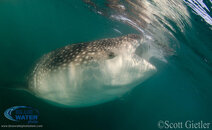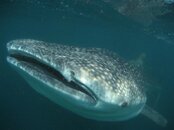What I means is that underwater without a wide angle lens your angle of coverage will be 60
In order to get a 3 meter whale shark in the picture that is actually not even a full adult you will need to be 3 meters away
If you wanted to get a silhouette from below you need to skin dive 4 meters deep then shoot this sounds challenging
You can instead shoot video and occasionally take a still of the head if you manage to be there without getting in the way
If you find a cooperative shark that feeds at the surface standing still you can easily take shots and they won't be blurred
I did a trip to Djubouti and at the time I had an IXUS65 with a wide angle UWL105AD
The camera only shot in program and happily selected speeds of 1/640 or 1/1250 I am sure the G12 will do the same
Just set the ISO to 100 and let the camera do the rest. If it is bright at the surface the aperture and shutter speed will come by default
In order to get a 3 meter whale shark in the picture that is actually not even a full adult you will need to be 3 meters away
If you wanted to get a silhouette from below you need to skin dive 4 meters deep then shoot this sounds challenging
You can instead shoot video and occasionally take a still of the head if you manage to be there without getting in the way
If you find a cooperative shark that feeds at the surface standing still you can easily take shots and they won't be blurred
I did a trip to Djubouti and at the time I had an IXUS65 with a wide angle UWL105AD
The camera only shot in program and happily selected speeds of 1/640 or 1/1250 I am sure the G12 will do the same
Just set the ISO to 100 and let the camera do the rest. If it is bright at the surface the aperture and shutter speed will come by default





